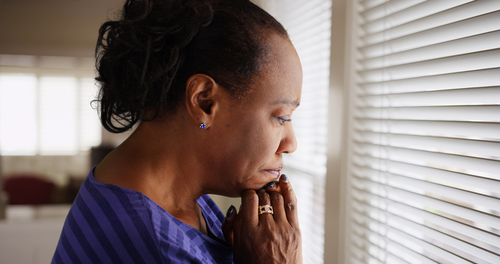Social Learning of Fear: Reducing Your Fear of the News

 Linda is unemployed and stays awake at night worrying about how to afford food for her teenaged children. Juan recently received a diagnosis of lymphoma and fears not living long enough to see his children grow up. Rick heard about a man his age whose car was hijacked at a gas station, and now he is afraid to drive to work. After Maria read a news story about a kidnapping in another city, she began having panic attacks while dropping her daughter off for school.
Linda is unemployed and stays awake at night worrying about how to afford food for her teenaged children. Juan recently received a diagnosis of lymphoma and fears not living long enough to see his children grow up. Rick heard about a man his age whose car was hijacked at a gas station, and now he is afraid to drive to work. After Maria read a news story about a kidnapping in another city, she began having panic attacks while dropping her daughter off for school.
It’s easy to see what all of these stories have in common. Fear is one of the most universal human experiences, a feeling that ties all humans together. It’s deeply uncomfortable and rooted in uncertainty—will I be safe? Will my loved ones be happy and healthy? How much pain will I have?
Catching fear from others
But there is one way these stories are different. While Linda and Juan's fears stem from direct life experience, Rick and Maria became afraid after hearing stories about other people. Rick’s car was not hijacked, and Maria’s child wasn’t kidnapped; yet their fear is as palpable as if these experiences had happened to them. This indirect transmission is called social learning of fear. Simply witnessing or hearing about a frightening event—which can happen daily for those who read the news or engage in social media—can trigger debilitating anxiety and decrease wellbeing.
Reduce fear with mindfulnessResearchers observed the power of socially learned fear in an experiment in which they asked people to watch a film of a person receiving an electrical shock every time a blue square appeared on a screen. They told the viewers that they would soon be undergoing a similar procedure, which, as you can imagine, inspired a great deal of fear and dread. The researchers observed the viewers’ skin conductance response (a way of measuring psychological arousal through the skin) and found that the people who were simply observing the film experienced a physical fear of the blue squares, as if they themselves had been the ones receiving the shocks.
Witnessing fear can be useful
Social fear learning certainly has its benefits. Babies, for example, learn to fear unsafe aspects of their environment (such as a hot stove) by following cues from their parents. Stories about burglaries remind people to lock their doors. One person getting caught in a riptide at the beach leads to many others being more cautious in the water.
 However, social fear learning can get out of control, especially in a media-saturated world. Multiple news outlets compete with one another by exploiting bad news and pushing out constant, alarmist headlines. Social media networks are a breeding ground for sensational stories about violence, disease, and war—and many of these stories are not even true!
However, social fear learning can get out of control, especially in a media-saturated world. Multiple news outlets compete with one another by exploiting bad news and pushing out constant, alarmist headlines. Social media networks are a breeding ground for sensational stories about violence, disease, and war—and many of these stories are not even true!
All of this can result in the proliferation of chronic fear, whose ill effects are well documented. Increased rates of cardiovascular disease, impaired memory, poor mental health, post-traumatic stress syndrome (PTSD), and even premature death can result from endless worrying over threats, both real and imagined.
Take charge of your fear
Let’s pause for a minute. If reading that last sentence caused panic (“Oh no! I’m definitely going to have a heart attack if I keep reading the news!”) instead of a positive response (“Wow, that’s fascinating—I’d like to work on ways to reduce my fear”), then you have a little taste of how easy it is to be negatively impacted by the information you read.
So now you know how socially learned fear works. Now, what can you do about it? Below are some tips.

10 Ways to Protect Yourself from Fear When Reading the News
1. Evaluate the risk.
What is your source? If you read it in the news, is it true, or is it designed to alarm you and make you pay more attention to that particular news outlet? Ask yourself: am I in danger right now? If so, do what you can to remove the danger. If not, remind yourself: I am not in danger right now.
2. Cultivate strong relationships and experiences of shared joy with the people around you.
The fact that you can learn emotional responses through social interactions isn’t all bad. For example, being around a loved one can help dissipate fear and stress. Laugh together, spend time outside with friends, and learn to be both a good speaker and a good listener.
3. Unplug from technology.
Taking a “digital sabbatical” for a day each week can do wonders for your mental health. Turn off the computer and instead focus on things that bring you joy and increase wellbeing, such as creative hobbies, sports, or cooking healthy meals for the week.
4. Practice good safety habits and self-care.
Minimize risk in your life by wearing seatbelts in the car and helmets on your bike, practicing safe sex, always having a companion when in unfamiliar or dark neighborhoods, eating well, exercising, and scheduling regular checkups with a healthcare provider.
5. Reduce the overall stress in your life.
When you are stressed, you are more easily triggered, which creates a vicious cycle of fear and anxiety. There are plenty of ways to reduce stress and boost wellbeing, such as incorporating relaxation techniques into your everyday life. Mindful breathing is a great place to start.
6. Focus on the ways you are safe.
Do you have a home? A loved one you can call in an emergency? Are you able to eat every day? Practice feeling gratitude for these aspects of your life. You can even make a game of it—every morning before you get out of bed, try to think of two new things in your life that bring you safety and wellbeing.
7. Create a safe space for others.
Stop the cycle of socially learned fear by being mindful about how you trigger others. If your friend is a new mother, for example, don’t share with her the story you saw about a woman who left her child in a hot car. The best way to increase wellbeing for everyone is to begin with the people you know.
8. Feel the fear in small doses.
When it feels safe, notice how fear rises in the body. Is it tingly or sharp? Cold or hot? Is it primarily in your chest, hands, or somewhere else in the body? View the fear with friendliness and curiosity—it is a sign that you are human, and that you are interested in wellbeing and safety. If this feels overwhelming, shift your attention to a place in your body that does feel comfortable and safe.
9. Talk to someone about your fears.
Often describing our fears in detail alleviates the suffering associated with them. Talking to a friend, family member, or professional counselor about what scares you can help lift the burden tremendously.
10. Write in a journal.
Describing your fear in detail can sometimes help create a distance so you can consider the situation objectively. What seems like an inevitable terror in your mind might be a boring (or funny!) story on the page.
Remember: fear itself is not the enemy. It is a normal response to potential threats, and in many cases, the discomfort associated with fear can keep you safe. Learning to distinguish real threats from unlikely ones is the key to making sure fear and anxiety doesn’t disrupt your wellbeing.
Debbie, J., Olson, A. (2017). Social fear learning: From animal models to human function. Trends in Cognitive Science; 21(7), 546-555.
Olsson, A., Phelps, E.A. (2007). Social learning of fear. Nature Neuroscience; 10, 1095-1102.



